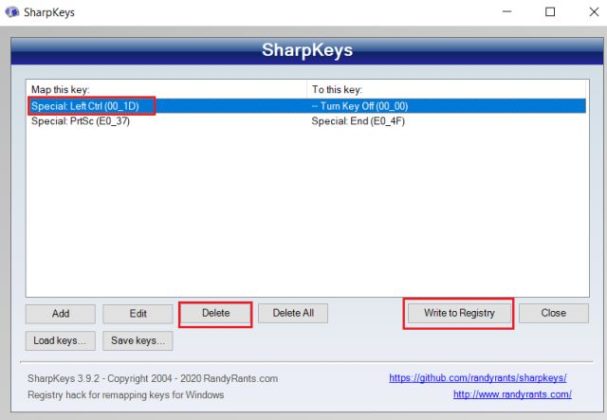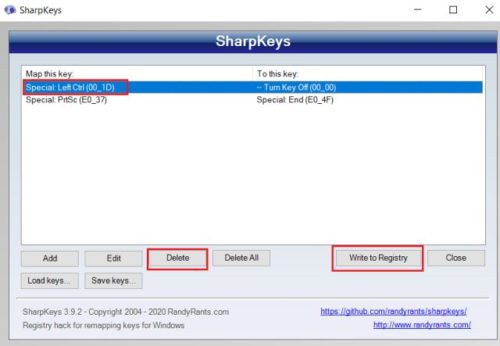

- SHARPKEYS NOT WORKING WINDOWS 7 DRIVERS
- SHARPKEYS NOT WORKING WINDOWS 7 DRIVER
- SHARPKEYS NOT WORKING WINDOWS 7 PRO
- SHARPKEYS NOT WORKING WINDOWS 7 PC
- SHARPKEYS NOT WORKING WINDOWS 7 WINDOWS 7
Not only can it remap keys, it can assign macro programs to them. (Wolof, Cherokee and Scottish Gaelic, for example, are only supported in Windows 8.) I mention it for completeness, but it would be overkill for your purposes.įinally, there’s AutoHotKey.
SHARPKEYS NOT WORKING WINDOWS 7 WINDOWS 7
This would be handy if you needed to create a keyboard to handle more than one language, or one of the languages that Windows 7 doesn’t support. Of course, the ultimate in keyboard tweaking is the free Microsoft Keyboard Layout Creator (MSKLC). It also has a “teach mode”, though it’s still not as easy to use as SharpKeys. KeyTweak 2.30 is a more sophisticated (but abandoned) program that also provides a drawing of a keyboard, but it can handle “speciality” keys. Also, it doesn’t include special hotkeys, but it does include some small advertisements. The drawback is that this probably doesn’t match the keyboard you have. MapKeyboard is a very small program that doesn’t need to be installed, and it’s based on a graphical representation of a standard keyboard.
SHARPKEYS NOT WORKING WINDOWS 7 PC
After changing any keys, click the “write to Registry” button and then restart your PC for the changes to take effect. Select the key you want to change on the left hand side, and then select what you want the key to do on the right. SharpKeys is a simple program that provides two lists of keys: “From” keys on the left and “To” keys on the right.
SHARPKEYS NOT WORKING WINDOWS 7 DRIVERS
Note, however, that success is not guaranteed: some “non standard” keys are controlled by drivers and Windows can’t redirect those. I’d start with SharpKeys but use whatever works for you. Well known examples include SharpKeys, KeyTweak, and MapKeyboard. This avoids having to grapple with HKEY_LOCAL_MACHINE\SYSTEM\CurrentControlSet\Control\Keyboard Layout. The simplest way to change keyboard mappings is, as mentioned, to use a free utility that will change the registry for you. Perhaps your delete key has been remapped by a program or by accident or by some odd registry corruption. However, keys can be changed to do different things by editing the Windows registry.
SHARPKEYS NOT WORKING WINDOWS 7 DRIVER
If you have the location and the language set correctly, and a suitable driver installed, the keyboard should work correctly. This is usually docked in the taskbar, where you can easily get to it. (You have two keyboards: the Toshiba laptop has one built in.)Īnother tab refers to the Language Bar, which is used for switching between languages. This will allow you to add or remove a keyboard and set the default input language. After that, click the tab for Keyboards and Languages, and then the button for Change Keyboards. Next, click the Location tab to make sure your location is set correctly, eg United Kingdom. Now, open the control panel, find the entry for “Clock, Language and Region” and click where it says “Change keyboards or other input methods” to bring up the Properties sheet. You should always have a current backup of your work, and before changing Windows, you should create a “restore point” so that you can easily return your PC to its current state. Most drivers are self-installing, but they can be installed manually.Īs always, don’t do things you can’t undo. If not, search for the exact name of the model you have, or look through Microsoft’s list.

If so, you can download the correct driver, IntelliType 8.2 64-bit for Windows 7, from Microsoft’s website.
SHARPKEYS NOT WORKING WINDOWS 7 PRO
In this case, I’m not sure which keyboard you have, but I suspect it’s a Microsoft Digital Media Pro USB keyboard. If not, you can download one from the supplier’s website. If Windows recognises the keyboard, it may provide one. In these cases, Windows will need a suitable device driver. For example, a “media keyboard” may have extra keys for things like play/pause, volume up, and volume down. Extended keyboardsįurther problems can arise with extended keyboards that provide keys for opening programs or controlling media events that weren’t standard key assignments on typewriters or early computer terminals. It’s very easy to do this by accident, which is probably why so many people hit the £ sign and see a # appear instead. The double-quote (“) and ampersand keys are also swapped.įor future reference, if both UK and US layouts are available, you can swap between them by pressing left alt-shift. UK users want a pound (£) sign, which was not part of the original standard ASCII character set. UK keyboards obviously have a different layout from French and German keyboards, but the most common problems are due to the much smaller differences between UK and US settings.

If a key is producing the wrong response, check that Windows has the correct settings for your location and the language used by your keyboard.


 0 kommentar(er)
0 kommentar(er)
